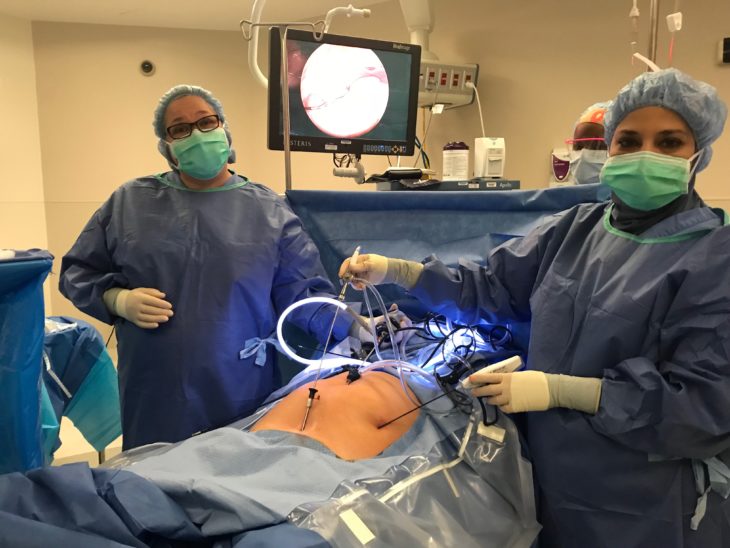by Mona Orady, MD
Obstetrician-Gynecologist
Director of Robotic Surgery, Saint Francis Memorial Hospital, San Francisco
I learned to perform mini-laparoscopy surgery about five years ago, and I have been performing it regularly for the last two years. Now I can use this modality for almost every gynecologic laparoscopic surgery that I perform, including simple hysterectomy, salpingectomy, ovarian cystectomy, oophorectomy, management of hemorrhage, ectopic pregnancy, and ovarian torsion. For extremely complex surgeries such as complex hysterectomy, severe endometriosis, or large myomectomy, I prefer a reduced port robotic assisted approach, with or without the addition of mini-laparoscopy instruments.
When colleagues ask me about my reasons for using mini-laparoscopy, it’s difficult for me to compare it to traditional laparoscopy because the difference is amazing. With mini-laparoscopy, we utilize instruments that are 3mm or less in diameter, rather than 5mm or above like traditional laparoscopy. The effect is more delicate surgery, often accompanied by faster healing and less trauma and pain, with tiny incisions that fade away in a few weeks.
Advantages for Patients
Mini-laparoscopy’s 2 to 3mm incisions are so small that they don’t even need stitches – just a bandage or skin glue. A few weeks later, the most we might see is a tiny dot. A lot of my patients are young women who are concerned about the prospect of having visible scars on their bellies. Some young women with endometriosis even avoid surgery because they don’t want scars or pain after surgery. They are thrilled to learn about mini-laparoscopy and thus are more likely to accept the treatment they need.
Postoperatively, there are no major restrictions on patients’ activities after mini-laparoscopy. They can go home one or two hours after surgery and go back to work in one or two days, and they do not need narcotic pain relievers (just ibuprofen as needed for a few days).
Mini-Laparoscopy Instruments
To perform mini-laparoscopy, surgeons need a mini-laparoscopy set and trocars with or without the addition of disposable percutaneous instruments, including a 3 mm scope and an HD camera. Because the tools are a little more delicate than those used for standard laparoscopy, we trained our cleaning staff to sterilize the instruments and trained our OR staff to handle them without breaking them. The fact that mini-laparoscopy instruments are reusable makes the procedures less expensive than standard laparoscopy, which utilizes mostly disposable trocars in addition to some disposable instruments.
Learning Curve
Mini-laparoscopy is not a difficult modality to learn, but there are a few things to get used to. Because the scope is small, we have to zoom in more, making the field of view smaller than we’re accustomed to with a 5mm scope. Smaller incisions can make it a little harder to keep the flow of CO2 inside, so when using energy, we sometimes need to pause to evacuate smoke or let the CO2 insufflate again.
With smaller, thinner mini-laparoscopy instruments, we work more delicately. It’s the difference between painting with a large brush or a small brush or feather. Making smaller and more delicate movements – for example, making more, smaller cuts with the scissors – takes some practice and finesse.
CO2 Laser for Mini-Laparoscopy
To incorporate the CO2 laser in mini-laparoscopy, I use the Lumenis UltraPulse Duo laser and its 1mm laser fiber, articulated through handpieces designed for the larynx, that have a 2mm diameter. I sometimes use malleable handpieces and bend them intracorporeally. This approach is very effective. For example, for endometriosis, I use a combination of the laser and excision with scissors. The CO2 laser is ideal for excising cells on the surface of organs, ovaries, and the uterus because it offers more controlled depth of penetration, minimizing damage to these underlying tissues. Its increased precision also helps with excision around the rectum or ureter. The mini-laparoscopy approach plays a vital part in keeping incisions small and minimizing pain, while allowing for eradication of all disease.
Getting Started
In the last few years, I have spoken about mini-laparoscopy at many meetings and symposia. Surgeons can watch videos of me online, as well as of other surgeons performing mini-laparoscopy. I think once surgeons see the technology and understand that it is a straightforward modality with strong advantages for our patients, more people will adopt mini-laparoscopy for gynecology and other specialties.
The content presented on this page is provided for informational and/or educational purposes. This material represents the views and opinions of its authors and should not be construed as representing or reflecting the official position, views or opinions of the Society of Laparoendoscopic Surgeons. The authors of the work are solely responsible for its content.




